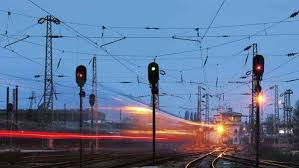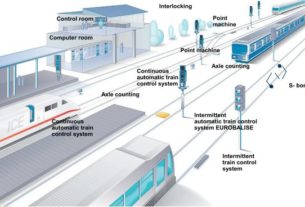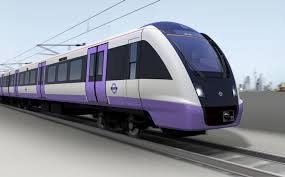Metro Rail Design of Electric Installations
Metro Rail Design of Electric Installations – (1) The design of all electric installations, namely transmission and distribution lines, sub-stations, switching station, rigid overhead current collection system, regulated overhead equipment, third rail DC Traction System etc. as applicable, shall be according to approved standards laid down by the Central Government and the Central Electricity Authority Regulation, 2010, or any other law for the time being in force and wherever any departure from accepted norms becomes necessary, approval of the Central Government shall be obtained.
(2) Adequate protective arrangement shall be made to ensure that the public cannot come in contact with the electric equipment on line within the metro railway premises.
(3) Suitable protective screens shall be provided where live conductors pass under or over bridges. Where third rail DC traction is installed shrouds of suitable design shall be provided over the third rail.
(4) The structures supporting overhead equipment or the third rail, as the case may be, shall be designed in accordance with the relevant international and Indian standards. The wind pressure to be adopted shall be generally in accordance with IS 875-1987 (latest revision). Inside Metro Corridor tunnel, complete current collection system and its supporting system shall be as per relevant international/Indian standards and shall be capable of working safely under air piston effect during train operation.
(5) When the distribution system involves overhead wires carried on steel structures including bridges and roofs, or third rail on pedestals, and return circuit via running rails or earth, all such structures, masts and associated tracks shall be effectively earthed and bonded or other precautions taken to ensure that contact with the steel work or other conductive part of the structure will not be dangerous to the public and the metro railway staff, or the access to such areas shall be restricted.
In AC and DC traction, bonding and earthing shall be as per the approved code for bonding and earthing in respective areas. In case of elevated concrete structures and in the tunnels (except bored tunnels with precast segment lining) continuous earth bonding shall be provided by earthing the reinforcement of structures and connecting the same to over-head electrical structures or suitable structure earth cable. The steel handrails on viaducts, where provided, shall also be earthed.
(6) Earthing arrangements at power supply installations shall strictly conform to the international standards or Central Electricity Authority Regulation, 2010 and accepted codes of practices for bonding and earthing for AC and DC traction.
Adequate stray current control system shall be provided under DC traction System to avoid corrosion to steel reinforcement and other metallic parts of the tunnels and nearby structures. All precautions shall be taken to avoid Electro-magnetic effect in the environment as per relevant standards / approved design.
(7) The earthing system for the traction shall conform to requirements of IS-3043 and EN-50122 Part 1 and Part 2, as applicable, and the maximum rail potential shall not exceed specified limits.
(8) Earth wires shall be provided at appropriate locations as per EN 50122 standards. In complicated areas, structures may be connected to individual earthing stations.
(9) When overhead lines transmitting electric power (other than lines forming part of the railway traction equipment) have to be carried across metro railway track, the details of the equipment provided in connection with such lines shall be designed with the object of minimizing danger in the event of breakage and in accordance with stipulated regulations for electrical crossings. These details shall be approved by the Electrical Inspector to the Government of India.
(10) Lightening arrestors of standard or approved types shall be provided wherever they are necessary.
(11) All components of the equipment which carry live conductors shall be provided with devices approved by the Electrical Inspector to the Government to prevent unauthorised persons climbing them. Anti-climbing devices shall also be provided, wherever necessary on structures carrying high tension equipment within metro railway premises.
(12) Warning notices shall be erected in conspicuous position indicating the existence of live electrical equipment.


